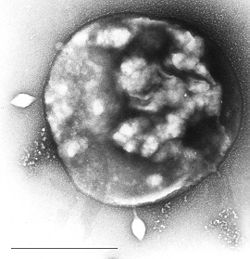Thermoproteati — Wikipédia
TACK
| Domaine | Archaea |
|---|
Les Thermoproteati sont un règne de procaryotes du domaine des Archées. Ils correspondent au clade des TACK[1] (acronyme de Thaumarchaeota, Aigarchaeota, Crenarchaeota et Korarchaeota) ou Filarchaeota[2].
Ils vivent dans différents milieux favorisant des microorganismes allant de thermophiles acidophiles à mésophiles et même psychrophiles, avec différents métabolismes, principalement anaérobie et chimiosynthétique.
Les TACK sont le groupe frère des Eukaryomorpha.
Systématique
[modifier | modifier le code]Le nom correct complet (avec auteur) de ce taxon est Thermoproteati Guy & Ettema 2024[3]. Le genre type est Thermoproteus Zillig & Stetter 1982[3]. Ce règne correspond au super-phylum TACK, défini en 2011 par les microbiologistes Lionel Guy (d) et Thijs Ettema (d) de l'université d'Uppsala[4].
Thermoproteati a pour synonymes[3] :
- Crenarchaeida Luketa 2012
- Korarchaeota Barns et al. 1996
- Proteoarchaeota Petitjean et al. 2014
Liste des phylums
[modifier | modifier le code]Selon la LPSN (15 mars 2025)[3] :
- "Candidatus Aigarchaeota" Nunoura et al. 2011
- "Candidatus Augarchaeota" corrig. Nunoura et al. 2011
- "Crenarchaeota" Garrity and Holt 2001
- "Candidatus Geothermarchaeota" Jungbluth et al. 2017
- "Candidatus Korarchaeota" Ludwig and Klenk 2001
- "Candidatus Methanomethylicota" corrig. Vanwonterghem et al. 2016
- "Candidatus Nezhaarchaeota" Wang et al. 2019
- "Nitrososphaeraeota" Oren et al. 2015
- Nitrososphaerota Brochier-Armanet et al. 2021
- "Nitrososphaerota" Whitman et al. 2018
- "Candidatus Thaumarchaeota" Brochier-Armanet et al. 2008
- "Thermoproteaeota" Oren et al. 2015
- Thermoproteota Garrity and Holt 2021
- "Thermoproteota" Whitman et al. 2018
- "Candidatus Verstraetearchaeota" Vanwonterghem et al. 2016
Cladogramme
[modifier | modifier le code]D'après Tom A. Williams et al., 2017[5] et Castelle & Banfield, 2018[6] (DPANN) :
| Neomura |
| ||||||||||||||||||||||||||||||||||||||||||||||||||||||||||||||||||||||||||||||||||||||||||||||||||||||||||||||||||||||||||||||||||||||||||||||||||||||||||||||||||||||||||||||||||||||||||||||||||||||||||||||||||
Publication originale
[modifier | modifier le code]- (en) Markus Göker et Aharon Oren, « Valid publication of names of two domains and seven kingdoms of prokaryotes », International Journal of Systematic and Evolutionary Microbiology, Society for General Microbiology (d), vol. 74, no 1, (ISSN 1466-5026 et 1466-5034, OCLC 807119723, DOI 10.1099/IJSEM.0.006242).
Notes et références
[modifier | modifier le code]- ↑ Guy et Ettema 2011, p. 580-587
- ↑ Thomas Cavalier-Smith 2014, « The Neomuran Revolution and Phagotrophic Origin of Eukaryotes and Cilia in the Light of Intracellular Coevolution and a Revised Tree of Life ». Cold Spring Harbor Laboratory Press. DOI 10.1101/cshperspect.a016006
- List of Prokaryotic names with Standing in Nomenclature (LPSN), consulté le 15 mars 2025.
- ↑ (en) Lionel Guy et Thijs J. G. Ettema, « The archaeal 'TACK' superphylum and the origin of eukaryotes », Trends in Microbiology, Elsevier, vol. 19, no 12, , p. 580-587 (ISSN 0966-842X et 1878-4380, PMID 22018741, DOI 10.1016/J.TIM.2011.09.002).
- ↑ (en) Tom A. Williams et al., Integrative modeling of gene and genome evolution roots the archaeal tree of life, publié en 2017 DOI 10.1073/pnas.1618463114
- ↑ (en) Castelle, C.J., Banfield, J.F., « Major New Microbial Groups Expand Diversity and Alter our Understanding of the Tree of Life », Cell, vol. 172, no 6, , p. 1181-1197 (PMID 29522741, DOI 10.1016/j.cell.2018.02.016)
- ↑ (en) Kiley W. Seitz, Nina Dombrowski, Laura Eme, Anja Spang, Jonathan Lombard et al., « Asgard archaea capable of anaerobic hydrocarbon cycling », Nature Communications, vol. 10, , article no 1822 (DOI 10.1038/s41467-019-09364-x).
Voir aussi
[modifier | modifier le code]Articles connexes
[modifier | modifier le code]Liens externes
[modifier | modifier le code]- (en) Catalogue of Life : Thermoproteati Guy & Ettema, 2024 (consulté le )
- (en) LPSN : Thermoproteati Guy & Ettema 2024 (consulté le )
- (en) NCBI : Thermoproteati (taxons inclus) (consulté le )
- (fr) TAXREF : Thermoproteati Guy & Ettema (consulté le )


 French
French Deutsch
Deutsch